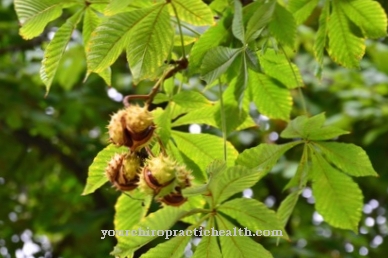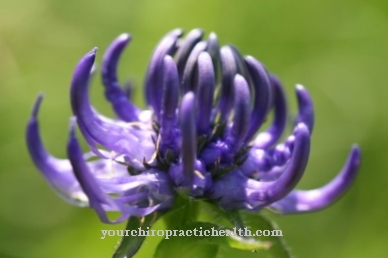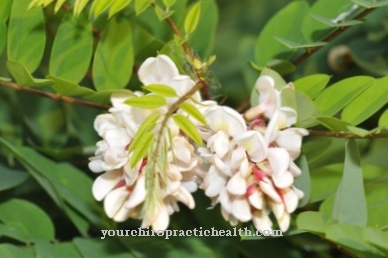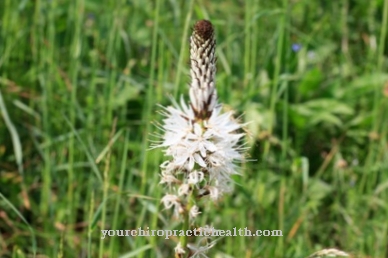Of the Fever clover is a slightly toxic marsh and aquatic plant of the northern hemisphere. The roots as well as the leaves and herbaceous components of the plant are used as remedies and in this context are mainly used in tea blends. Fever clover has an appetizing and digestive effect, but can also cause headaches or diarrhea if overdosed.
Occurrence & cultivation of fever clover

Of the Fever clover is a perennial and herbaceous marsh and water plant. The plant is related to the gentian and can be classified in the category of slightly poisonous medicinal plants. Fever clover is also called Bitter clover and is the only monotypical species in the genus of the fever clover family. It reaches heights of growth between around ten and 30 centimeters.
Bitter clover species are distributed over the entire northern hemisphere. In Central Europe, the plant blooms between April and June. Its flowers are white-reddish and grow in a cluster-like arrangement. The fever clover is rooted in the lowlands and on subalpine altitudes either in the water or in the swamp. The species of clover often grows submerged or even swimming in shallow waters. The plant is rarely found in raised bogs. On the other hand, it is all the more common in intermediate moors.
Other popular locations are headwaters of rivers or swamp forests. The botanist speaks of this type of plant as an arctic-nordic floral element. In Germany, the fever clover is now an endangered species due to the closure of natural swamps and bodies of water. The fever clover may no longer be removed from nature here without a permit.
Effect & application
Both the herb and the roots and leaves of the fever clover are used for medicinal products and thus the treatment of diseases. The dry leaves of the plant are often referred to as a medicinal drug. Today the leaves are mainly used in connection with tea mixtures. Most of these teas are mixtures of equal proportions of fever clover, sage, wormwood and centaury.
One teaspoon of the mixture is usually added to 250 milliliters of boiling water. A patient takes this infusion around half an hour before a meal. Because of the slightly toxic effect of the plant, a daily dose between 1.5 and three grams is the maximum. Occasionally, bitter clover extracts are also found in schnapps or herbal liqueurs. In the past, feverish clover tea was also used to gargle with sore throats.
In the 19th century, some patients even consumed bitter clover as a juice because of its medicinal properties. The people used the freshly squeezed juice of the plant that was just beginning to bloom. They mixed this bitter clover juice with alcohol in equal proportions. Meanwhile, bitter clover juice is no longer common in pharmaceuticals. In modern homeopathy, the feverish clover remedies Trifolii fibrii from potency D1 are used from time to time. For all applications and products made from fever clover, stomach and intestinal ulcers as well as intestinal inflammation or existing diarrhea are contraindications.
Apart from that, the user has to consider the slight toxicity and anticoagulant effect of bitter clover for all types of application. If you have wounds, you should not use the plant because of the anticoagulant properties of the medicinal plant. The toxicity is primarily due to the alkaloids it contains. When overdosing the fever clover, headaches sometimes arise because of these active ingredients. Vomiting or diarrhea can also occur as part of a severe overdose.
Importance for health, treatment & prevention
According to records, bitter clover was first used as a medicinal product in the 16th and 17th centuries. Back then, farmers gave sick grazing animals the dried leaves or an infusion of them to treat gastrointestinal complaints. The medicinal plant was presumably used in ancient times. Documentation of this has not yet been found.
Although the plant was also given to lower fever in the 17th century, this effect of bitter clover has not yet been confirmed. The plant still plays a role against loss of appetite and indigestion. In addition to the appetite-stimulating effect, homeopathy combines a blood-purifying, blood-improving and blood-increasing effect with the peat plant. Anti-inflammatory, diuretic, sweat-inducing and antispasmodic effects are also associated with bitter clover.
A general stimulus for digestion and cleansing of the body. The decisive active ingredient of the plant are the bitter substances. These substances include, for example, the secoiridoid glycosides, dihydrofoliamenthin and menthiafolin, which the fever clover contains. Flavonoids are also produced when the plant is digested. Flavonoids in particular are associated with antioxidant and antiviral properties. The tannins of the fever clover also promise healing effects due to their anti-inflammatory properties.
In the past, fever clover was mainly used in private. Since bitter clover is considered an endangered plant species in Germany today, private individuals are not allowed to collect them without further ado. The medical relevance of fever clover has meanwhile declined despite its beneficial ingredients. However, selected garden shops offer bitter clover as a pond plant.
Anyone who has a fever clover in their garden can theoretically collect and dry their leaves. The right time to collect is when the plant is in bloom. The leaves are removed together with a small petiole and dried in a shady and airy place. The three years can be kept in the dried form. They can be processed into tea blends if the dosage instructions are followed.








.jpg)



















